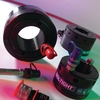Components compared | Bolt tensioners
Hydraulic bolt tensioners
1 January 2013Just as there are many different ways to tighten a bolt on a valve, heat exchanger, reactor coolant pump, reactor pressure vessel, or steam generator, there are many different tightening tools. By Will Dalrymple
One particular family of tools to apply very high tensioning forces on to bolts uses hydraulic pressure, not to turn (torque) the bolt but to lift it. The general idea is simple. A hydraulic load cell screws down on the spare bit of bolt thread above the bolt’s tensioning nut (at least as much height as the bolt is wide) until it rests on the same face as the bolt. The load cell incorporates a piston which, under the pressure of hydraulic fluid supplied via a high-pressure hose, is forced to extend outwards, stretching the bolt, and raising the tensioning nut off the surface of the face. An operator can then manually turn the tensioning nut down until it is tight against the face. As hydraulic pressure is released, the piston retracts, the bolt springs back, and the tensile load force is transferred from the hydraulic load cell to the tensioning nut.
The process is more accurate, more controllable and less damaging than torquing the bolt manually, which imparts frictional loads on the threads and outer surfaces.
Tentec recently supplied two bolt tensioners to Dongfang Electric for the Chinese AP1000’s steam generator blind flange. It had tensioning forces of 557kN, for which its pump generates a pressure of 1500 Bar. Nova Machine Products, a subsidiary of Curtiss-Wright, can accommodate a 10-inch-diameter stud, and a tensioning force of 10 million pounds (4.5 tons) with an operating pressure of up to 30,000 psi (2040 Bar). David Metzger at Boltight says that for steam generator casings, its systems go up to 40,000 psi to generate a bolt stress of 30,000 psi. Reactor pressure vessel tensioning requires 20-40,000 foot-pounds of energy, according to Biach.
Producing such high pressures could pose a safety risk, but vendors tend to use small amounts of hydraulic oil at low flow rates to reduce the risks. “You can’t have both high pressure and high flow, which poses a danger to personnel,” says Steve Greenwell, Nova vice president of sales and marketing. “Water jet cutting systems have both high pressure and high flow.” Tentec says that such a small amount of oil is used in its system—a capful per nut—that in a leak the oil simply vapourises.
Vendors claim that there is essentially no upper limit in terms of tensions and in bolt size, although the amount of elbow room around the nut might impose a constraint. Tentec has tightened bolts that were 25 inches [635 mm] in diameter for a (non-nuclear) US forging press. However, there may be a lower limit: Tentec’s smallest hydraulically-tensioned bolts were 3/4 inch [19 mm] in diameter.
The simplest arrangement consists of just one hydraulic load cell, which might include piston, bridge and locknut separately, or integrated into one unit. Pressure is supplied via a high-pressure hose from a hydraulic pump.
A single tensioning or de-tensioning process only takes a few minutes, although set-up and put-away require time as well. When faced with a flange with 16 or more bolts, the amount of time required to go around tensioning or de-tensioning every second bolt becomes prohibitively large. Multi-stud tensioners have evolved for this application. In one type, a manifold block splits the hydraulic fluid into multiple lines, each of which sends an equal portion to a different hydraulic load cell. In another type, such as Tentec’s, the hydraulic fluid runs through holes machined into sides of tensioners that are attached together in rings, or partial rings. Because these systems are modular, they can scale very large. Tentec’s largest multi-bolt ring had 88 bolts.
Some applications, such as turbo-generator flanges, require multiple opening and closing sequences to check clearances with turbine blades, says Metzger at Boltight, in which case speed is important.
Nova integrates the load cell and hose nipple into a permanent bolt. The advantage of these HydraNuts comes with the need to deal with many bolts at once; it is quicker, says Steve Greenwell; every bolt can be tensioned or de-tensioned in a single operation, without having to install a hydraulic cell on each bolt, and without having to share one tool among many bolts. Of course the Nova HydraNuts cost more than mechanical bolts, from two to 10 times, depending on diameter and intended purpose—whether they are safety-related or not, he says.
A further enhancement for single stud tensioning is an all-in-one system, such as those of Biach, which not only integrate electric hydraulic pump, but also are driven by a computer-controlled user interface. One Biach self-contained tensioner can control two or three others working together on one RPV closure. SKF also produces an automated rig for reactor pressure vessel bolt tensioning.
At most levels, hydraulic tensioners for nuclear applications are tools that are custom-built for the application, and may require bespoke tooling. (Possible hydraulic bolt tensioning safety extras could include pressure relief valves and overstroke limiters). There is a good reason for taking care; even though the equipment might only cost a few thousand pounds, their failure could lead to a very expensive delay.
Author Info:
This article was first published in the December 2012 issue of Nuclear Engineering International. By Will Dalrymple, editor of NEI





